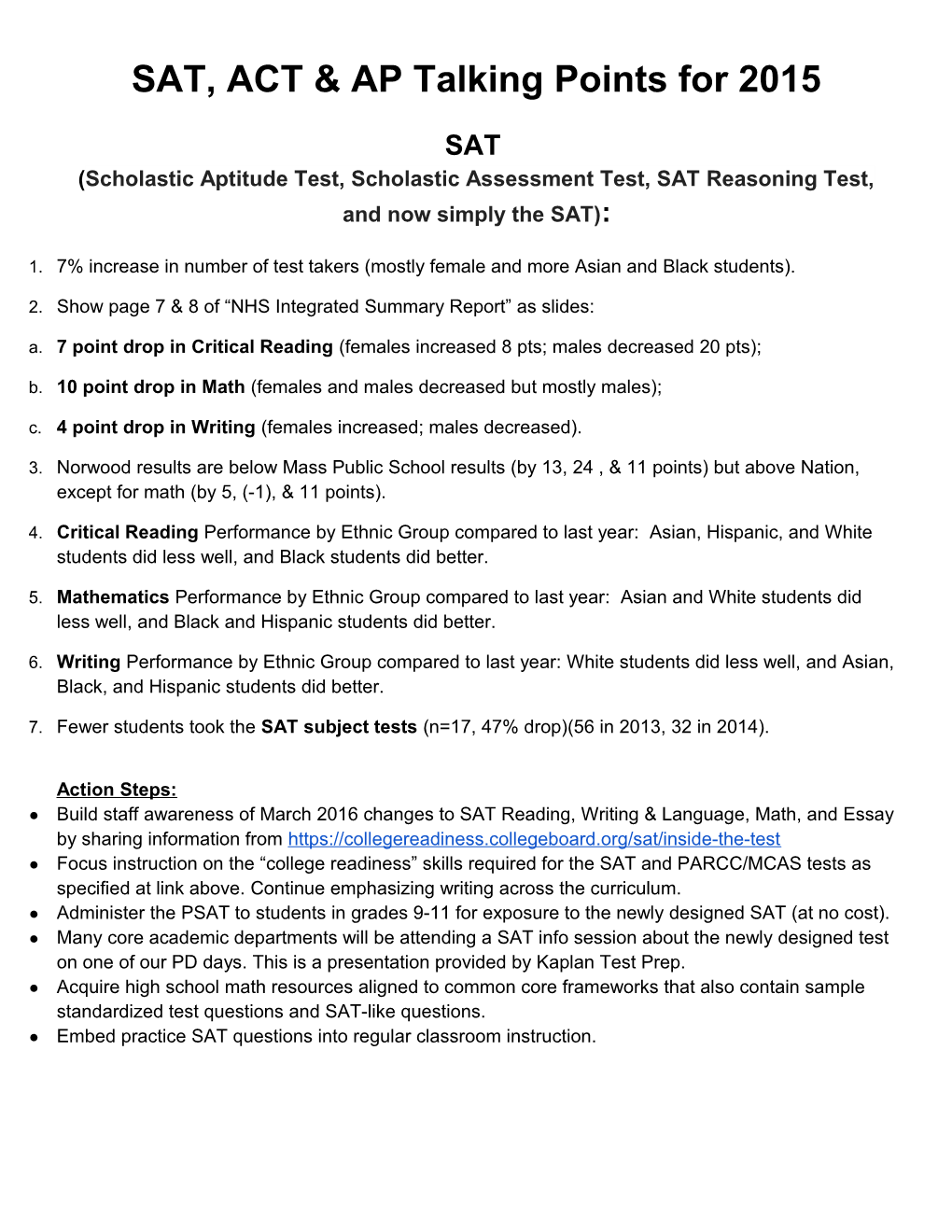SAT, ACT & AP Talking Points for 2015
SAT
(Scholastic Aptitude Test, Scholastic Assessment Test, SAT Reasoning Test, and now simply the SAT):
- 7% increase in number of test takers (mostly female and more Asian and Black students).
- Show page 7 & 8 of “NHS Integrated Summary Report” as slides:
- 7 point drop in Critical Reading (females increased 8 pts; males decreased 20 pts);
- 10 point drop in Math (females and males decreased but mostly males);
- 4 point drop in Writing (females increased; males decreased).
- Norwood results are below Mass Public School results (by 13, 24 , & 11 points) but above Nation, except for math (by 5, (-1), & 11 points).
- Critical Reading Performance by Ethnic Group compared to last year: Asian, Hispanic, and White students did less well, and Black students did better.
- Mathematics Performance by Ethnic Group compared to last year: Asian and White students did less well, and Black and Hispanic students did better.
- Writing Performance by Ethnic Group compared to last year: White students did less well, and Asian, Black, and Hispanic students did better.
- Fewer students took the SAT subject tests (n=17, 47% drop)(56 in 2013, 32 in 2014).
Action Steps:
●Build staff awareness of March 2016 changes to SAT Reading, Writing & Language, Math, and Essay by sharing information from
●Focus instruction on the “college readiness” skills required for the SAT and PARCC/MCAS tests as specified at link above. Continue emphasizing writing across the curriculum.
●Administer the PSAT to students in grades 9-11 for exposure to the newly designed SAT (at no cost).
●Many core academic departments will be attending a SAT info session about the newly designed test on one of our PD days. This is a presentation provided by Kaplan Test Prep.
●Acquire high school math resources aligned to common core frameworks that also contain sample standardized test questions and SAT-like questions.
●Embed practice SAT questions into regular classroom instruction.
ACT:
(previously the American College Testing)
- 87% increase in number of students taking the ACT (2014-2015 #s)(39-73).
- Average scores have increased:
- English: 21.6 to 22.4 (out of 36)
- Mathematics: 23.2 to 23.3
- Reading: 22.9 to 23.6
- Science: 22.1 to 23.3
- Composite: 22.6 to 23.3
- We continue to improve our percents and greatly narrowed the District-State gap in percent of ACT-Tested Students Ready for College Level Coursework (2014 v. 2015).
- English Composition: 77-85 to 81-85%. Closing gap from 8 to 4 points.
- Algebra: 64-72 to 67-71%. Closing gap from 8 to 4 points.
- Social Science: 49-65 to 62-67%. Closing gap from 16 to 5 points.
- Biology: 44-58 to 58-61%. Closing gap from 14 to 3 points.
- Meeting All 4 above: 31-47 to 44-51%. Closing gap from 16 to 7 points.
Action Steps:
●Members of the guidance staff explain the ACT format and content in both Junior and Senior Seminars. Students can access a brief “quiz” that allows them to see what assessment (ACT or SAT) is more appropriate for them based on their skill base.
●
Advanced Placement (AP):
- There was a 9% increase in the number of students taking APs (106-116)(a few more Asian, Black & Hispanic students participated). 22 more AP tests were taken.
- Compared to last year, there was no % increase in the overall # of 3, 4, or 5s (n=133)(females showed 6% increase; males showed 7% decrease) though more students earned 3 , 4, or 5 on an AP exam (83-90).
- Exams that showed a decrease in test takers (2014-2015 #s): Biology (15-2), English Language & Composition (5-0), Mathematics: Calculus AB (34-30), Spanish Language (7-0), Statistics (13-6).
- Exams that showed an increase in test takers (2014-2015 #s): Computer Science A (1-6), English Literature and Composition (16-33), History: United States (53-59), Physics 1 (0-24), Psychology (6-12).
- Areas of Strength (% and # of 3, 4, & 5s):
- English Literature & Composition: 90% (30/33)
- US History: 70% (41/59)
- Math Calculus AB: 71% (21/30)
- Psychology: 100% (12/12)
- Statistics: 100% (6/6)
- Areas of Growth:
- Physics 1 (new test): 17% (4/24)
Action Steps:
●Maintain & build on areas of strength above,
●Continue to advocate for funding needed to build a strong middle school foreign language program in grades 6-8 so more HS students can be prepared to take the AP foreign language tests.
●
